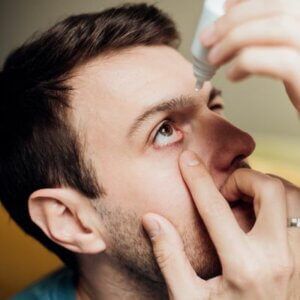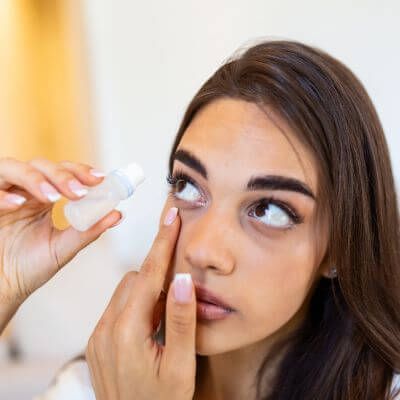Summer Spotlight: What Is Pterygium and How Is It Treated?
Summer is in full swing, which means it’s time for some fun in the sun! However, it also means an elevated risk to your eye health. While the cause is not known, one possible consequence of the sun’s rays is pterygium, also known as
surfer’s eye
. This benign growth can cause you to feel self-conscious and possibly interfere with your vision, making it important to know what pterygium is and how it is treated.
Pterygium tends to be a minor issue for most people. However, it can cause problems by spreading to the cornea, along with other symptoms. The best form of protection is UV-absorbing sunglasses that fit well and have durable, high-quality lenses. Symptoms of a pterygium, most commonly ocular irritation, can be treated with over-the-counter medications but surgery is necessary in some cases.
What Is Pterygium?
A pterygium (surfer’s eye) is a noncancerous growth on your eye and is usually considered only a minor problem. They develop when the conjunctiva , the very front layer that lines your eyes and eyelids, begins to grow abnormally. A pterygium usually begins in the white of your eye (the sclera ) closest to your nose.
A pterygium may continue growing on and off throughout your life or it may stop at some point, but it won’t spread to other parts of your body. They are most common in adults in their 20s through 40s, although they can develop at any point in life.
Most people who develop a pterygium:
- Live in sunny climates
- Work outdoors
- Are male
Over time, the abnormal tissue can spread to your cornea , which helps your eye focus light to create the images that you see. A pterygium can lead to vision problems at this point which may require medical treatment.
Click here to learn more ways that UV radiation can harm your vision!
Symptoms
Common symptoms of pterygium include:
- Irritation and burning
- Dryness
- Redness
- Blurred vision
Restricted eye movement has been known to occur in rare instances.
Causes
The exact cause of pterygium is currently unknown. However, experts suspect that exposure to UV light may play a role. Many people who develop the condition experience prolonged exposure to the sun’s rays, reinforcing the importance of protective eyewear that blocks the sun’s ultraviolet radiation.
UV ray exposure isn’t the only suspected cause. People who develop a pterygium may have a genetic predisposition to the abnormality. Other experts suspect that it is caused by an HPV infection ( human papillomavirus ), but more research is needed to support this view.
Prevention
Preventing pterygium can be difficult since its cause is unknown. On the other hand, prolonged UV exposure may play a key role in their development. This only reinforces the importance of wearing quality sunglasses all year long to protect your eyes. Fortunately, there are a few simple things to keep in mind to find the best pair of sunglasses possible and reduce your risk.
They are:
- UV absorption
- Frame fit
- Lens durability
- Lens quality
For more on the importance of UV-absorbing sunglasses, click here !
UV Absorption
The most important factor when choosing a pair of sunglasses is their ability to absorb UV light. While polarized lenses may reflect glare, they don’t actually block the sun’s rays. That’s why you should read the label of different sunglasses to learn their absorption percentage. Choose a pair with 99 – 100% absorption or labeled “up to 400 nm,” which equals 100% UV absorption. Be wary of very cheap glasses found online or in the store.
Frame Fit
The fit of your frames plays an important role in blocking the sun’s rays. This is because a loose fit can allow UV rays to slip between your face and frames and reach your eyes, possibly increasing your risk of pterygium as well as:
- Cataracts
- Photokeratitis
- Macular degeneration
- Pinguecula
When trying on frames, make sure to choose a pair that fits closely to your face. A good way to tell if they’re a good fit is if they don’t touch your eyelashes and are even with your eyebrows. For the best protection, opt for a pair of wraparound sunglasses.
Lens Durability
Sunglass lenses come in different materials based on your needs. Common construction materials include plastic, polycarbonate plastic, and shatterproof glass. Polycarbonate plastic is one of the best options since you will likely be wearing them outside. They offer added protection, especially if you live an active lifestyle.
The one thing to keep in mind with polycarbonate lenses is that they scratch easily. Make sure to get a scratch-resistant coating to protect your investment.
Lens Quality
Many people think there isn’t a difference between the quality of different lenses. However, trying on a few different pairs and testing them will prove this to be untrue.
You can test the quality of lenses by:
- Looking at a patterned surface like a tiled floor
- Covering one eye and holding the sunglasses away from your face
- Moving the sunglasses horizontally and vertically
Lines and patterns will remain intact and straight when looking through a high-quality pair of sunglasses. However, distorted lines are an indication that they are low-quality and you need to keep searching.
Pterygium Treatment in Knoxville, TN
Pterygiums are a cosmetic concern in most instances and won’t require treatment if you don’t have any symptoms. On the other hand, there are cases where treatment is needed. In many cases, your pterygium symptoms can be treated with over-the-counter lubricating eye drops or prescription drops, gels, and ointments.
Surgery is the only way to completely remove the pterygium. This may become necessary if the growth is:
- Getting larger
- Causing vision problems
- Affecting your eye movement
- Affecting your confidence
Unfortunately, surgery may not completely rid you of a pterygium. This is because they often grow back, especially if you’re under 40 years of age. Other treatments may be recommended to help prevent this. It can also be more difficult to remove once it has grown back. Like cataracts, many eye surgeons avoid removing them until they are causing significant symptoms.
Do you need treatment for a pterygium? Contact us today to schedule your appointment!
Also known as surfer’s eye , a pterygium is an eye growth with minor if any symptoms. However, it can affect your vision if it spreads to your cornea. While the cause is not known, wearing sunglasses with UV eye protection may help reduce your risk. Most cases can be treated with over-the-counter and prescription eye drops, although advanced cases may require surgery.
Baptist Eye Surgeons is an ophthalmological practice in Knoxville, TN, and Morristown, TN. Give us a call at 865-579-3920 for more information or to schedule an appointment .


MORRISTOWN
SEVIERVILLE
TENNESSEE VALLEY - LASER CENTER
TENNESSEE VALLEY - EYE CENTER



